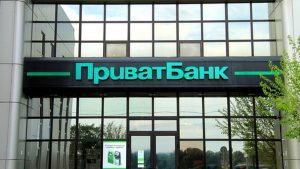
Ukrainian banks in July-September 2020 closed 251 structural divisions, as of October 1 their regional network consisted of 7,329 branches.
According to data posted on the website of the National Bank of Ukraine (NBU), in the third quarter, Oschadbank ceased the operation of 166 branches (reducing their number to 1,931), PrivatBank some 83 (to 1,750), TAScombank 11 (to 87), Kredobank five (to 83).
In addition, Ukrbudinvestbank (to 47) and UkrSibbank (to 278) closed four branches in the last quarter, the regulator noted.
It is also indicated that in July-September this year, state-owned Ukrgasbank opened 21 offices, expanding its regional network to 269 branches, A-Bank opened five branches (to 235) and Megabank (to 153) and IBOX Bank (to 42) opened three branches each.
According to the National Bank, as of October 1 Oschadbank remains the leader in terms of the number of branches (1,931), PrivatBank ranks second (to 1,750), Raiffeisen Bank Aval ranks third (456), UkrSibbank is in the fourth place (278) and Ukrgasbank is fifth (269).

State-controlled PrivatBank in January-May continued to top the list of the most profitable Ukrainian banks, declaring UAH 19.62 billion of net profit, while state-owned Ukreximbank recorded the largest loss, as a month earlier, of UAH 1.59 billion.According to the National Bank of Ukraine (NBU), Oschadbank (UAH 3.56 billion) ranked second in the list of the most profitable banks, Raiffeisen Bank Aval (UAH 1.7 billion) ranked third. FUIB is in the fourth position (UAH 1.13 billion), and Citibank (UAH 759.66 million) is fifth.
According to the central bank, in January-May 2020, Bank Credit Dnipro ranked second (UAH 245.89 million) in terms of losses, Prominvestbank (PIB, UAH 126 million) ranked third, Pravex-Bank (UAH 63.72 million) ranked fourth and BTA Bank (UAH 39.38 million) was fifth.
In general, in the five months of 2020, the net profit of banks increased by 23.6%, to UAH 28.96 billion from the corresponding figure a year earlier (UAH 23.43 billion).
Some 59 of 75 banks operating in Ukraine were profitable during this period, according to NBU data.
According to the statistics of the National Bank, in terms of total assets, PrivatBank (UAH 590.59 billion) ranked first for the indicated period, Oschadbank (UAH 310.78 billion) ranked second, Ukreximbank (UAH 220.71 billion) ranked third, Ukrgasbank (UAH 156.43 billion) ranked fourth, while Raiffeisen Bank Aval (UAH 100.9 billion) ranked fifth.

The COVID-19 pandemic pushes for cash to go to “normal Fintech,” in particular, the development of digital currencies of central banks, Economist and Professor at the Institute of Sciences Po Sergei Guriev has said. “The future is in the digital currencies of central banks. Central banks will gradually move away from cash, you will have Fintech in hryvnias… Everyone will have an account with the central bank,” he said during a public interview organized by the Kyiv School of Economics.
Guriev added that this trend is a challenge for commercial banks.
“You will have an electronic hryvnia. You will no longer have the cash hryvnia,” he said.
Previously, central banks argued that cash should be avoided by the need to combat the shadow economy, but in the current conditions, the pandemic pushes to it.
“Now it’s clear that this pandemic is not the last. And cash is a source of infection. Therefore, the transition to digital payments will accelerate. But it will not be bitcoin, it will be a normal Fintech,” the economist said.

The total number of transactions (noncash and cash) using payment cards issued by Ukrainian banks amounted to 1.385 billion units, and their amount was UAH 920.5 billion in January-March 2020, which is 24.5% and 15.6%, respectively, more than in the same period of 2019, according to the data of the National Bank of Ukraine (NBU), released on its website on Thursday, May 21.
According to the data, noncash transactions prevailed in both quantity and amount, for example, Ukrainians carried out 1.183 billion noncash transactions (85.4% of the total) for a total of UAH 503 billion (54.6% of the total).
The regulator said that in the first quarter, the largest number of transactions using cards accounted for settlements in retail chains, namely 50.3%, however, person-to-person transfers prevailed by the amount of 41.3%, the average size of which was UAH 1,505.
The NBU said that the total number of issued payment cards in Ukraine as of April 1, 2020 reached 68.6 million. However, in March all expenditure transactions were carried out using 53.4% of all payment cards, in February with use of 53%, in January with use of 53.2% payment cards.
The regulator said that from January, banks began to report to the NBU monthly, whereas earlier they did it on a quarterly basis, and therefore, active payment cards were also calculated every month, however, comparison with last years’ indicators became impossible.
According to the NBU, a third, or 11.3 million of payment cards that were used for expenses in March were either contactless or tokenized.
Thus, in March 8.9 million contactless payment cards and almost 2.5 million tokenized ones were used for transactions, which is 16% and 11.2% more than in January 2020.
The regulator said that nine out of ten (90.2%) of trading POS terminals provide contactless payment, whereas eight out of ten were contactless in 2019. When compared with the beginning of 2020, there is a 0.7% decrease in the number of working trading POS terminals due to lockdown restrictions introduced in March.
According to the NBU, the number of payment terminals in the trading network per one million of permanent residents as of April 1, 2020 amounted to 8,300.
“The regional distribution of the terminal network in Ukraine is quite irregular. The smallest number of payment devices per an inhabitant is observed in the west of the country and in Luhansk and Donetsk regions,” the regulator said, adding that Kyiv city and Kyiv, Dnipropetrovsk and Kharkiv regions prevail in the number of payment cards and payment devices.
Thus, as of April 1, 2020, some 70 participants of card payment systems were registered in Ukraine.

The National Bank of Ukraine (NBU) in addition to conventional short-term tools of refinancing of banks is introducing long-term refinancing for the period of up to five years, the NBU said on Wednesday. “This step is aimed at meeting several goals at once, related both to maintaining financial stability in the country and stimulating economic growth,” the regulator said.
According to its calculations, the long-term refinancing mechanism will support hryvnia bank lending, enhancing the effect of other measures taken by the National Bank over the past months: lowering the refinancing rate and introducing incentive reserve standards.
“Secondly, the new instrument will serve as an additional guarantee of maintaining sufficient liquidity in the banking system. This, in particular, is also important for the smooth conduct of client operations in the face of deteriorating market sentiment due to the spread of the coronavirus disease COVID-19,” the NBU said.
According to the report, the frequency of tenders to maintain bank liquidity, volumes, terms and other parameters of long-term refinancing will be determined by individual decisions of the Board of the National Bank after consideration of these issues by its Monetary Policy Committee.
The interest rate on long-term refinancing loans will be floating as the NBU refinancing rate, which can be changed in accordance with the decisions of the board, along with a constant value in percentage points, which is valid on the day the loan is issued and will remain unchanged for the entire period of use.
If necessary, banks will be able to repay such loans ahead of schedule at any time.
In order to reduce risks in the provision of refinancing loans, the NBU also improved the standards for collateral instruments, the central bank said. In particular, it is possible to directly transfer the bank’s funds from the repayment of the National Bank’s deposit certificates and income on them to partial early repayment of debt, if the certificates are included in the collateral pool. It is also determined that a foreign currency in such a pool should be placed by the bank on NBU accounts as a cash cover without paying interest on it.
“Thus, favorable conditions are created for the development of long-term lending to entrepreneurs and the population, in particular mortgages, loans for business development and others. At the same time, banks will be able to apply for long-term refinancing in situations where they will need additional liquidity,” the regulator said.
At the same time, the NBU said that today, the hryvnia liquidity of the banking system exceeds UAH 200 billion, the currency liquidity is $8 billion, so the introduction of a new tool is more likely to be preventive in the event of a more serious crisis in the global economy.
The central bank said the introduction of a long-term refinancing mechanism was approved by the NBU Board decision No. 29 issued on March 17 amending the regulation on the interest policy of the NBU and decision No. 30 approving changes to the regulation on the application of standard instruments for regulation of the liquidity of the banking system by the NBU. These changes entered into force on March 19, 2020.

State-controlled PrivatBank headed the rating of the most profitable Ukrainian banks in 2019, declaring UAH 32.609 billion in net profit, while Pravex-Bank recorded the largest loss last year at UAH 121.502 million.
According to the National Bank of Ukraine (NBU), Raiffeisen Bank Aval (UAH 4.749 billion) ranked second in the list of the most profitable banks, and FUIB (UAH 2.623 billion) was third, rising two positions in the fourth quarter. UkrSibbank (UAH 2.580 billion) ranked fourth, while OTP Bank (UAH 2.537 billion) ranked fifth, rising two lines.
At the same time, state-controlled Ukreximbank fell from the fourth position it held in the nine months of 2019, to the 11th one, declaring UAH 1.002 billion of net profit, and Ukrgasbank climbed six positions, to the 10th one, posting UAH 1.299 billion.
According to the central bank, Sky Bank ranked second in terms of losses, its net loss amounted to UAH 27.543 million, Alpari Bank ranked third (UAH 18.435 million), Cominvestbank (UAH 17.982 million) ranked fourth, while Ukrainian Bank for Reconstruction and Development ranked fifth (UAH 4.409 million). At the same time, Bank Credit Dnipro, which according to the results of its activities for the first nine months of 2019 was third in terms of loss, declared UAH 309.903 million in net profit and ranked 18th.